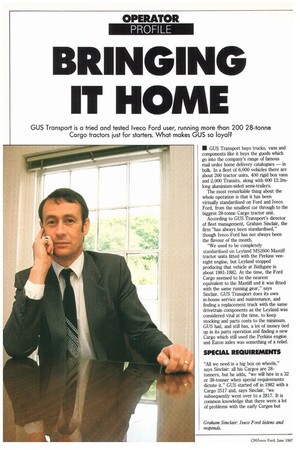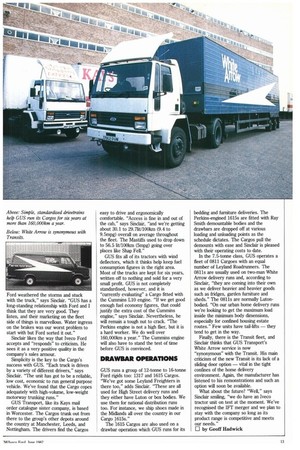OPERATOR PROFILE
Page 98

Page 99

If you've noticed an error in this article please click here to report it so we can fix it.
BRINGI NG IT HOM
• GUS Transport buys trucks, vans and components like it buys the goods which go into the company's range of famous mail order home delivery catalogues — in bulk. In a fleet of 6,000 vehicles there are about 200 tractor units, 400 rigid box vans and 2,000 Transits, along with 600 12.2mlong aluminium-sided semi-trailers.
The most remarkable thing about the whole operation is that it has been virtually standardised on Ford and Iveco Ford, from the smallest car through to the biggest 28-tonne Cargo tractor unit.
According to GUS Transport's director of fleet management, Graham Sinclair, the firm "has always been standardised," though 1veco Ford has not always been the flavour of the month.
"We used to be completely standardised on Leyland MS2600 Mastiff tractor units fitted with the Perkins veeeight engine, but Leyland stopped producing that vehicle at Bathgate in about 1981-1982. At the time, the Ford Cargo seemed to be the nearest equivalent to the Mastiff and it was fitted with the same running gear," says Sinclair. GUS Transport does its own in-house service and maintenance, and finding a replacement truck with the same drivetrain components as the Leyland was considered vital at the time, to keep stocking and parts costs to the minimum. GUS had, and still has, a lot of money tied up in its parts operation and finding a new Cargo which still used the Perkins engine and Eaton axles was something of a relief.
SPECIAL REQUIREMENTS
"All we need is a big box on wheels," says Sinclair: all his Cargos are 28tonners, but he adds, "we will hire in a 32 or 38-tonner when special requirements dictate it." GUS started off in 1982 with a Cargo 2517 and, says Sinclair, "we subsequently went over to a 2817. It is common knowledge that there were a lot of problems with the early Cargos but Ford weathered the storms and stuck with the truck," says Sinclair. "GUS has a long-standing relationship with Ford and I think that they are very good. They listen, and their marketing on the fleet side of things is marvellous. Water ingress on the brakes was our worst problem to start with but Ford sorted it out."
Sinclair likes the way that Iveco Ford accepts and "responds" to criticism. He sees it as a very positive quality in the company's sales armour.
Simplicity is the key to the Cargo's success with GUS. "Each truck is driven by a variety of different drivers," says Sinclair. "The unit has got to be a reliable, low cost, economic to run general purpose vehicle. We've found that the Cargo copes adequately with high-volume, low-weight motorway trunking runs."
GUS Transport, like its Kays mail order catalogue sister company, is based in Worcester. The Cargos trunk out from there to the group's other depots around the country at Manchester, Leeds, and Nottingham. The drivers find the Cargos easy to drive and ergonomically comfortable. "Access is fine in and out of the cab," says Sinclair, "and we're getting about 30.1 to 29.711t/1001an (9.4 to 9.5mpg) overall on average throughout the fleet. The Mastiffs used to drop down to 56.5 lit/100km (5mpg) going over places like Shap Fell."
GUS fits all of its tractors with wind deflectors, which it thinks help keep fuel consumption figures in the right area. Most of the trucks are kept for six years, written off to nothing and sold for a very small profit. GUS is not completely standardised, however, and it is "currently evaluating" a Cargo fitted with the Cummins L10 engine. "If we get good enough fuel economy figures, that could justify the extra cost of the Cummins engine," says Sinclair. Nevertheless, he will remain a tough nut to crack. "The Perkins engine is not a high flier, but it is a hard worker. We do well over 160,000km a year." The Cummins engine will also have to stand the test of time before GUS is convinced.
GUS runs a group of 12-tonne to 16-tonne Ford rigids too: 1317 and 1615 Cargos. "We've got some Leyland Freighters in there too," adds Sinclair. "These are all used for High Street delivery runs and they either have Luton or box bodies. We use them for national distribution runs too. For instance, we ship shoes made in the Midlands all over the country in our Cargo 1615s."
The 1615 Cargos are also used on a drawbar operation which GUS runs for its bedding and furniture deliveries. The Perkins-engined 1615s are fitted with Ray Smith demountable bodies and the drawbars are dropped off at various loading and unloading points as the schedule dictates. The Cargos pull the demounts with ease and Sinclair is pleased with their operating costs to date.
In the 7.5-tonne class, GUS operates a fleet of 0811 Cargoes with an equal number of Leyland Roadrunners. The 0811s are usually used on two-man White Arrow delivery runs and, according to Sinclair, "they are coming into their own as we deliver heavier and heavier goods such as fridges, garden furniture and sheds." The 0811s are normally Lutonbodied. "On our urban home delivery runs we're looking to get the maximum load inside the minimum body dimensions, especially for confined housing estate routes." Few units have tail-lifts — they tend to get in the way.
Finally, there is the Transit fleet, and Sinclair thinks that GUS Transport's White Arrow service is now "synonymous" with the Transit. His main criticism of the new Transit is its lack of a sliding door option — vital in the tight confines of the home delivery environment. Again, the manufacturer has listened to his remonstrations and such an option will soon be available.
What about the future? "Well," says Sinclair smiling, "we do have an Iveco tractor unit on test at the moment. We've recognised the 1FT merger and we plan to stay with the company so long as its product range is competitive and meets our needs."
by Geoff Hadwick
























































































































